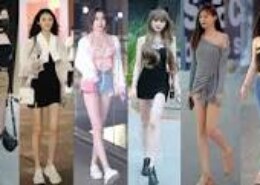Fashion trends refer to the prevailing styles, designs, and preferences that are popular within the fashion industry during a specific period of time. These trends can encompass various aspects of clothing, accessories, footwear, hairstyles, makeup, and even lifestyle choices. Fashion trends are influenced by a variety of factors including cultural shifts, social movements, technological advancements, economic conditions, and celebrity endorsements.
Fashion trends are constantly evolving, with new styles emerging while others fade away. They can be driven by designers showcasing their collections on runways, celebrities wearing particular brands or styles, street style photography capturing everyday fashion choices, and social media influencers influencing consumer preferences. Fashion trends can also be influenced by historical references, cultural heritage, and global events.
Some fashion trends become widespread and mainstream, while others remain niche or subcultural. Fashion trends can vary across different regions, demographics, and age groups. Additionally, trends often cycle and recycle over time, with certain styles from past decades experiencing revivals and reinterpretations in contemporary fashion.
Overall, fashion trends play a significant role in shaping the aesthetic landscape of the fashion industry, reflecting the ever-changing tastes and preferences of consumers while also showcasing the creativity and innovation of designers and brands.
Fashion in China is a dynamic and ever-evolving industry, influenced by a myriad of factors ranging from cultural heritage to global trends. As we step into 2024, the landscape of Chinese fashion continues to evolve, with innovative styles, sustainability efforts, and technological advancements reshaping the industry. In this article, we will explore 10 new trends shaping the fashion scene in China this year.
1. Sustainable Fashion:
Witness a surge in eco-consciousness among Chinese consumers, driving demand for sustainable fashion practices, from ethically sourced materials to eco-friendly production processes. Chinese consumers are embracing sustainable fashion practices. Brands are incorporating sustainability into their designs to meet the demand for environmentally conscious clothing.
2. Digital Fashion Shows:
Embrace the digital era with virtual fashion shows gaining prominence, offering brands an innovative platform to showcase collections amidst the ongoing digital transformation and evolving consumer behaviors.
3. Streetwear Influence:
Streetwear continues to dominate the fashion scene in China, with urban youth driving the trend. Influenced by hip-hop culture and international street style, Chinese streetwear brands are gaining popularity both domestically and globally.
4. Gender-Fluid Fashion:
Traditional gender norms are being challenged in Chinese fashion, with an increasing number of brands embracing gender-fluid designs. From androgynous silhouettes to unisex clothing lines, fashion in China is becoming more inclusive and diverse.
5. Tech-Integrated Clothing:
With China leading the way in technological innovation, tech-integrated clothing is gaining traction in the fashion industry. From smart textiles that monitor health metrics to garments embedded with LED lights, technology is transforming the way we interact with fashion.
6. Retro Revival:
Nostalgia is a powerful force in fashion, and in 2024, Chinese designers are drawing inspiration from the past. Retro styles from the 80s and 90s are making a comeback, with bold colors, oversized silhouettes, and vintage prints reimagined for the modern consumer.
7. Cultural Heritage:
Chinese culture has a rich history that serves as a constant source of inspiration for fashion designers. In 2024, we are seeing a resurgence of traditional Chinese elements in fashion, from intricate embroidery to traditional patterns and motifs.
8. Customization and Personalization:
As consumers seek unique and individualized experiences, customization and personalization are becoming increasingly important in the fashion industry. From made-to-measure clothing to personalized accessories, brands in China are catering to the desire for bespoke fashion.
9. Virtual Influencers:
Social media influencers have long been a driving force in the fashion industry, but in 2024, virtual influencers are gaining prominence in China. These computer-generated personalities collaborate with brands, create content, and engage with followers on social media platforms, blurring the lines between reality and virtuality.
10. Crossover Collaborations:
Collaboration is key in the fast-paced world of fashion, and in 2024, we are seeing an increasing number of crossover collaborations between brands from different industries. From fashion-tech partnerships to collaborations between luxury brands and streetwear labels, these alliances are driving innovation and creativity in Chinese fashion.
Conclusion
As we look ahead to the future of fashion in China, it is clear that the industry is undergoing a period of rapid transformation. From sustainability initiatives to digital innovation, the trends shaping Chinese fashion in 2024 reflect a commitment to creativity, diversity, and forward-thinking. By embracing these trends, designers, brands, and consumers alike can contribute to a more inclusive, sustainable, and technologically advanced fashion landscape in China and beyond.

